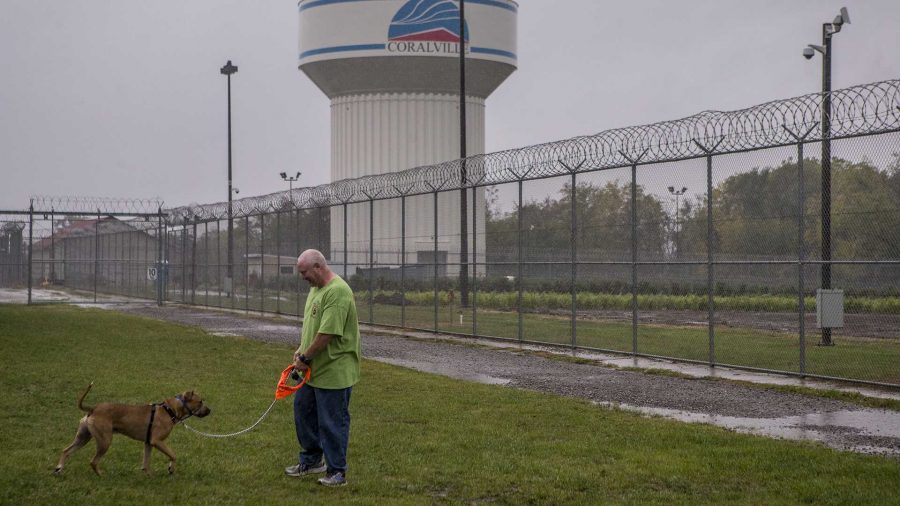Iowa prison allows inmates to train dogs
Terry, an inmate volunteer, on Tuesday walks Russ, a shelter dog who was placed at the Iowa Medical & Classification Center as part of a program in which inmates teach shelter dogs obedience and help to rehabilitate them for adoption or placement. (Nick Rohlman/The Daily Iowan)
October 12, 2017
When Liz Ford enters the Iowa Medical & Classification Center, she places a large paper bag of dog treats, food, and toys on a conveyer belt, being sent through a scanner to rule out the possibility of weapons or other contraband entering the facility.
Ford, the supervisor for the Iowa City Animal Services and Animal Care and Adoption Center, oversees a program pairing inmates in the facility with dogs in need of basic training from the adoption center. Warden James McKinney introduced the program to the prison in April 2016, with hopes to show the community that the facility was not just a penitentiary.
They started with only one dog; in January, shelter dogs became available. There are currently 11 resident dogs.
“It was kind of a dream, to have the dogs here,” Josh, one of the inmates that leads the program, said. “I didn’t really think it would happen, then one day, a dog came.”
Currently, there are in-house therapy dogs and community service dogs, training to work with owners in wheelchairs, elementary school students, and those in need of a therapy animal.
“Some people have said, ‘Why are dogs going to prison? They didn’t do anything wrong,’ ” Terry, another program leader, said. “But if you saw how well they’re taken care of, you’d want them to come here.”
In order to become affiliated with the program, inmates must apply, interview, and earn their spot through hard work and dedication to the training. Individuals also have to continuously study and prepare to be a trainer, and are paired up with dogs with which they can correct specific problems. If behavioral or disciplinary issues occur with the offenders, their dogs are taken away for three months and they must reapply to the program.
“[The program] has really made a difference in our lives,” Josh said. “Not just in the people who needed it, but for people who didn’t know they needed it.”
While the inmates working in the program undoubtedly experience the most impact from these animals, the IMCC staff feel the positive effects as well.
“When I’m having a bad day, I come down here,” Staff Liaison Amanda Jones said. “The dogs just love up on you.”
Jones is on-call to oversee the inmates while they train, providing assistance to individuals as needed. She can also perform duties that the inmates cannot, including transporting the dogs to the vet and purchasing necessary supplies.
The inmates live with the dogs, training them daily and working on commands as needed throughout the day. There are two additional training classes per week, along with meetings to discuss the dogs’ progress.
The prison yard is open for outdoor activities and exercise four to five times a day for general population inmates, and program participants use this time to take the dogs outside.
Once the dogs have completed their training in the prison, Ford and the shelter make sure that they are ready to be placed for adoption. They follow typical adoption protocols. The IMCC staff is informed when the dogs are ready to find homes and can apply to adopt them as well. For the inmates in the program, this is one of the most challenging aspects of the program.
“One of the things we learn is loss,” Josh said. “We learn about building bonds with the dogs, and then they’re taken away from us.”
Another challenge is helping the dogs become acquainted with situations that occur in life outside prison. The dogs are not used to certain objects, like cameras or other animals, which creates a need for increased training.
The program has experienced lots of growth since its inception, most noticeable by the increased number of dogs available. Iowa Department of Agriculture and Land Stewardship laws state foster organizations cannot have more than four animals that are over four months of age. The program became licensed as a kennel, due to their intake of animals from Hurricane Harvey.
“Any time someone has trouble in their life, they try to overcompensate by doing good,” Terry said. “This is a chance for us to do good, a very real, tangible, thing.”



